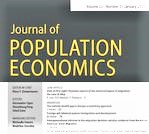A new paper published in the Journal of Population Economics finds that an early-life social safety net program has a sizeable impact on child health outcomes at birth.
Read more in:
Growing together: assessing equity and efficiency in a prenatal health program
Damian Clarke, Gustavo Cortés Méndez
Journal of Population Economics (2020) 33, Issue 3: 883-956
FREE READ LINK
Author Abstract: We study the acting mechanism of an early-life social safety net program and quantify its impact on child health outcomes at birth. We consider both the equity and efficiency implications of program impacts and provide a metric to compare such programs around the world. In particular, we estimate the impact of participation in Chile Crece Contigo (ChCC), Chile’s flagship early-life health and social welfare program, using a difference-in-differences style model based on variation in program intensity and administrative birth data matched to social benefits usage. We find that this targeted social program had significant effects on birth weight (approximately 10 grams) and other early-life human capital measures. These benefits are largest among the most socially vulnerable groups but shift outcomes toward the middle of the distribution of health at birth. We show that the program is efficient when compared to other successful neonatal health programs around the world and find some evidence to suggest that maternal nutrition components and increased links to the social safety net are important action mechanisms.
Access to the newly published complete Volume 33, Issue 3, July 2020.
LEAD ARTICLE OF ISSUE 3:
Blau, F.D., Kahn, L.M., Brummund, P. et al., Is there still son preference in the United States?.
Journal of Population Economics 33, 709–750 (2020). READ LINK FREE.
https://doi.org/10.1007/s00148-019-00760-7

Ends;
